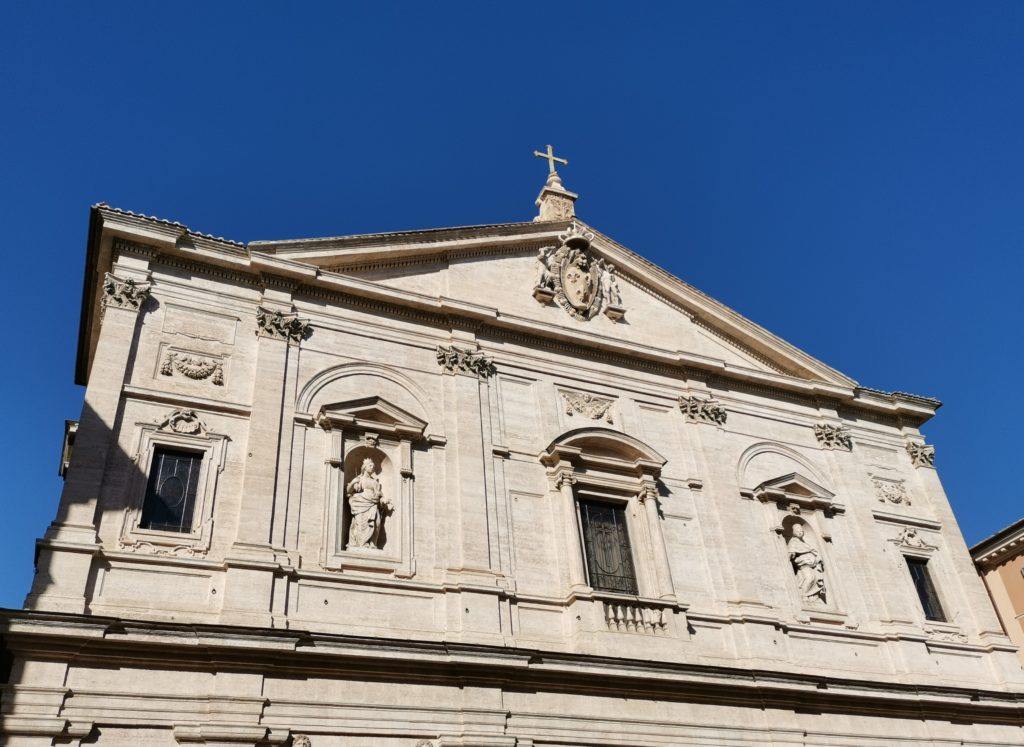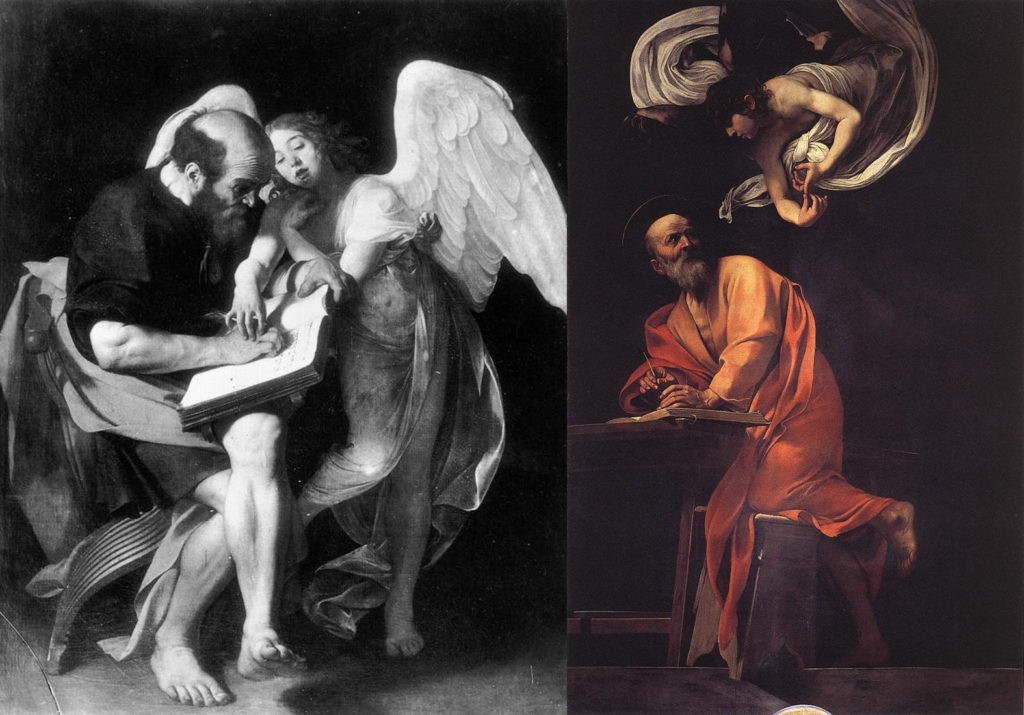Around 1592, an aspiring painter arrived in Rome in search of fame and fortune. The Eternal City didn’t welcome him – just a typical self-proclaimed genius without a single coin in his holey pocket! Moreover, the guy had a terrible temper: a scandal buzzed around him wherever he went. Only 21 years old, he had already been to prison for a fight.
The guy’s name was Michelangelo Merisi. This artist would later go down in history as Caravaggio, having taken the name from the little town where he grew up.
Three Heads a Day
At the beginning of his career, Merisi supported himself by painting insignificant details on the canvases of more or less successful older masters. They noticed his talent and willingly entrusted him with relatively responsible work, like depicting secondary characters in the background crowd. He easily painted three heads a day. The youth certainly could make his career in art calmly, step by step, yet he was not a person to remain on the sidelines for years.
Michelangelo Merisi did not stay long in any studio – he worked for a while and left, sometimes after quarreling with a potential teacher. He also often moved from one rented room to another.
The young rake didn’t leave a particular district of Rome, though – he always looked for housing in the vicinity of the Pantheon. Many of his peers, as cocky as Merisi himself, lived there; it was easy to find a cheap model among prostitutes at this place.
He preferred to paint directly from models, not trying to embellish them. He did not see anything shameful in portraying commoners and even petty crooks.
A local merchant accepted several of Merisi’s own pictures for sale. Two of them – The Fortune Teller and The Cardsharps – caught the eye of Cardinal Maria del Monte, a true aficionado of art. Del Monte immediately realized he had discovered a rare gem and offered the artist his patronage. Caravaggio received a studio in the Palazzo Madama belonging to the cardinal.
Promising Commission
There was a church just in front of the palazzo, the church San Luigi dei Francesi.

Long before Caravaggio arrived in Rome, the French Cardinal Matthieu Cointerel (or, as he was called in the Italian manner, Matteo Contarelli) acquired a chapel there. Contarelli decided to decorate the chapel with scenes from the life of his name-saint Matthew the Evangelist. The owner of the chapel left detailed instructions for the painter who would take on this job.
Contarelli hired a master, yet for more than two decades, the prospective executor of the order did not even prepare any rough drafts of the project. Then Contarelli died; his inheritors had to puzzle over finding a new contractor. The popular master Giuseppe Cesari frescoed the vault for them but became too occupied with papal commissions soon.
The influential clergy took responsibility for solving the problem. Del Monte, the patron of Caravaggio, offered his protégé as the performer of the order.
Caravaggio set to the task with enthusiasm and trepidation – he knew he was taking risks.
Michelangelo Merisi had never dealt with huge, multi-figured canvases or painted according to strict requirements; he was accustomed to working in a studio, not in the peculiar interior of a temple. If he failed, his career might be ruined.
The artist set solely one condition: he would paint not in the fresco technique, but in oil on canvas. This was because the fresco technique doesn’t let the artist correct the picture in the process of painting; he has to quickly and accurately. The masters who painted upon wet lime plaster usually relied on premade, carefully verified drafts. With regard to Caravaggio, he preferred to work without any sketches.
Even Geniuses Make Mistakes
Merisi began with the scene of the martyrdom. Working at it suddenly turned out to be a problem for the painter.
It seemed he strictly followed Contarelli’s instructions: the interior of a monumental temple served as the background; the evangelist was lying on the ground; Ethiopian soldiers ruthlessly attacked him with swords by the order of their king; a crowd of Christians watched the cruel killing in horror. The figures looked quite lifelike… and yet something went wrong. The artist himself felt this.
Caravaggio stopped to paint The Martyrdom for a while and moved on to the other scene.
When Merisi returned to the scene of the murder, he did not attempt to change the picture (incidentally, almost completed), but simply painted a new piece on top of it.
Caravaggio understood what mistakes he made.
First, the background details were completely superfluous; they merely distracted the eye. The artist applied the trick he had already used in his practice – he drowned the insignificant portion of the temple interior in darkness. Now, dramatically illuminated figures stood out forcefully against the murky background. Their physical presence became so believable that the viewers could feel themselves inside the reality created by the painter’s imagination.

Second, Merisi got rid of unnecessary characters on the canvas and radically redid the composition. Saint Matthew’s figure was lost among the figures of soldiers in the earlier version, and he appeared as a miserable, frightened old man; in the new variant of the piece, the artist positioned the closeup of the martyr in the center. This provided a strong effect: the waves of suffering have diverged from the wounded saint and splashed out of it.
Do you see the person staying in the very depth of the temple, at about the same distance from the saint as we are? His dark hair is disheveled and tangled, his features are distorted – he’s obviously terrified by what’s happening. The bystander of the tragedy recognizes he ought to run away but can’t. His face is Caravaggio’s face.
Space of a Wonder
The opposite wall of the chapel was intended for the scene of calling of St. Matthew. Apparently, Caravaggio carefully studied Contarelli’s guidelines again. Contarelli told to depict the publican at his seat in “a shop”:
(…) will be made a painting in which is to be painted St. Matthew within a shop, or actually room used for customs with various things pertaining to that service [and] with a counter such as is used by customs officials with books, and money as if a certain sum has just been paid, or however seems best. St. Matthew, dressed as seems fitting for that post, rises from the counter with desire of following Our Lord, who, passing along the street with his disciples, calls him to the apostolate; and in the actions of St. Matthew the painter is to show his craft. (1)
Merisi probably also reread the fragment of the Bible describing the calling of the publican. The Bible states Jesus Christ has seen the future evangelist “sitting at the tax collector’s booth” as He “went on from” the place where He had healed a paralyzed man (Matthew 9:2; Matthew 9:9). That means Jesus was somewhere in the street.
How to combine the incompatible? Merisi found a way.

At first, we think the setting of his painting is a room, but then note the window is lit from the inside. Look also at the position of Christ’s feet: he seemed to have already passed by and suddenly turned around.
Matthew is sitting at a wall under a canopy. A bright beam emphasizes the gesture of Christ: get up and follow me!
Startled Matthew points to himself with one hand and continues to count coins with the other. Caravaggio shows the split-second when the well-dressed official suddenly became a disciple of Jesus – a strange vagabond who “has no place to lay his head”, and says that people “shouldn’t store up for themselves treasures on earth” (2).
The Inconvenient Truth
The central part of the chapel was supposed to be decorated with a sculpture depicting St. Matthew at work on the Gospel. However, the sculptor responsible for the order fulfillment wasn’t able to satisfy his customers, so Merisi has been asked to create one more picture.
What he did shocked prelates, and still can shock us although we live in the 21st century and have relatively democratic views about the acceptable and the unacceptable in art.
Caravaggio painted a saint as a village fool who can hardly write. The angel patiently directs St. Matthew’s pen while the apostle is smiling broadly, almost laughing.
Such an interpretation of the episode of sacred history, despite its rudeness, is extremely convincing. After following Jesus Christ, Matthew remains a human being with his human experience (and, sorry, dirty feet). He has never written any books before; all he knew was how to collect taxes. Delighted with the wise lines which his pen is writing, Matthew doesn’t conceal his childlike admiration. Blessed are the pure in heart: for they shall see God…
The Сhurch categorically rejected the piece. The painting entered the collection of the aristocrat Giustiniani and subsequently ended up in Berlin. The canvas was destroyed during World War II; everything I will show you is from its black-and-white photo reproduction (on the left).

The patrons gave Caravaggio a second chance. The new version of the picture (the photo on the right above) was completely different: in it, a serious old man similar to a philosopher listens to the words of the angel with deep understanding. But the most powerful element of this painting is the dangerously tilted stool. Just a moment longer and it will fall on the viewer – for example, on a respectable cardinal.
The artist’s hopes were not in vain. Having completed the work in the Contarelli Chapel, he rocketed to fame. Influential Roman clergy, rich aristocrats, and especially older painters – everyone was talking about Michelangelo Merisi. The recognized masters of painting guessed that this young man would alter the course of art.
I am walking up to the church San Luigi dei Francesi and taking a step inside with a sinking heart. Many decades ago, the great Michelangelo Merisi da Caravaggio opened this door. It’s easy to find the Contarelli Chapel – there are many people next to it. Suddenly it becomes dark – to turn on the electric light in the chapel, somebody has to pay a coin. According to the inscription next to the apparatus, two minutes of light cost one euro.
I am standing in front of Caravaggio’s canvases for at least half an hour, and the light does not go out for more than several seconds – someone immediately hurries to toss another coin into the apparatus.
- An Augustinian Interpretation of Caravaggio’s “Calling of St. Matthew” – Thomas Troy, Studies in Iconography, Vol. 27, pp. 157-191, Board of Trustees of Western Michigan University through its Medieval Institute Publications, 2006
- Gospel of Matthew
- The Power of Art – Simon Schama, Ecco, 2006
- Таинственный Караваджо (Mysterious Caravaggio) – Константино д’Орацио, Эксмо, Москва, 2020

